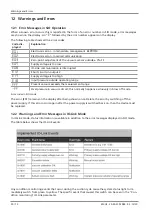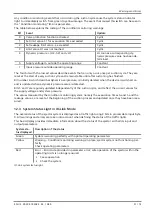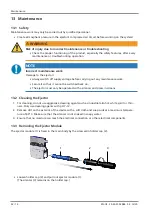
General Description of Functions
EN-US · 30.30.01.02084 · 02 · 12/20
37 / 72
7.25.4 Diagnostic Buffer
The condition monitoring warnings described above and the general error messages from the device are
saved in an integrated diagnostic buffer. The content of this memory is made up of the last 38 events,
starting with the most recent, and can be read out via an IO-Link parameter. For each event, the current
reading of the suction cycle counter cc1 is also saved to allow subsequent temporal assignment of the
events to other processes in the system. See the associated IO-Link Data Dictionary for the actual data dis-
play of the diagnostic buffer. The recording of these events is also active in SIO mode and the contents of
the memory is retained after a power failure.
The memory is deleted manually using the IO-Link system command “Clear diagnostic buffer” or also by
restoring the factory settings on the device.
7.25.5 EPC Data Buffer
The ejector provides a ten-stage data buffer to enable long-term monitoring and trend analysis of the
most important key figures in a handling process. The current measured values for the evacuation time t1,
leakage rate and dynamic pressure (vacuum during unobstructed intake), which are determined during
the suction cycle, can be saved in this buffer. The values are saved automatically, always together with the
execution of the autoset function in the condition monitoring area described above. For each data record,
the current reading of the suction cycle counter cc1 is also saved to allow subsequent temporal assign-
ment to other processes in the system. The contents of the EPC data buffer can be read out via an IO-Link
parameter. See the associated IO-Link Data Dictionary for the actual data display of this buffer. The con-
tents of the memory remains intact after a power failure.
7.25.6 EPC Values in the Process Data
To quickly and easily capture the most important results from the condition monitoring [CM], energy
monitoring and predictive maintenance functions, these are also made available via the process input
data of the device. The top 3 bytes of the process output data are also configured as a multifunctional
data range, consisting of an 8 bit value (“EPC Value 1”) and a 16 bit value (“EPC Value 2”).
The contents of this data that are currently supplied can be switched via the Process Data Out using the 2
“EPC-Select” bits.
The four possible ways in which this data is configured are listed in the table below:
EPC Values 1
PD Out
EPC-Select
PD In Byte 1
EPC Value 1
EPC-Select Ac-
knowledge
00
Current inlet pressure (unit 0.1 mbar)
0
01
Condition monitoring
1
10
Leakage rate (unit 1 mbar/s)
1
11
Supply voltage (unit 0.1 V)
1
EPC value 2
PD Out
EPC-Select
PD In Byte 2
EPC Value 2
EPC-Select Ac-
knowledge
00
Current vacuum value (unit 1 mbar)
0
01
Evacuation time t1 (unit 1 ms)
1
10
Last measured dynamic pressure (unit 1 mbar)
1
11
Air consumption in the last cycle (unit 0.1 NL)
1
The switch is made depending on the structure of the automation system with some time delay. However,
to ensure that the different pairs of values can be read efficiently through a controller program, the bit
EPC-Select-Acknowledge is provided in the process input data. The bit always accepts the values shown in
the table.
To read out all EPC values, the procedure illustrated in the following diagram is recommended:
















































